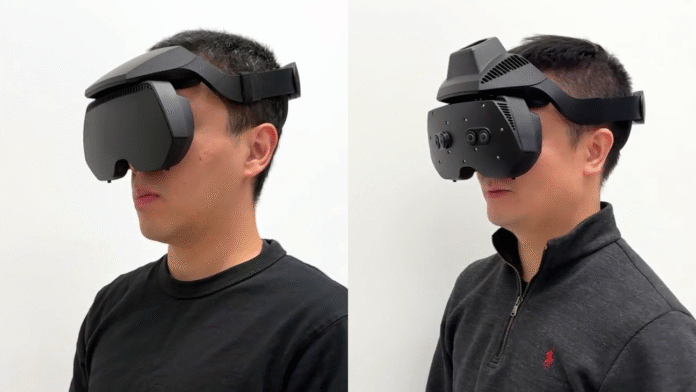Contents
Meta Unveils Revolutionary Prototype Headsets with Ultra-Wide Field of View at SIGGRAPH 2025
Meta’s Display Systems Research team has developed two prototype headsets with an ultra-wide field of view, showcasing a significant breakthrough in virtual reality technology. The prototypes, which will be demoed at SIGGRAPH 2025, achieve a 180° horizontal by 120° vertical field of view in a form factor comparable to current consumer devices, paving the way for a more immersive and realistic VR experience.
The announcement of Meta’s prototype headsets has sent shockwaves throughout the tech industry, with many experts hailing it as a major milestone in the development of virtual reality technology. According to the Display Systems Research team, the prototypes have been designed to push the boundaries of what is currently possible with head-mounted displays, with the ultimate goal of passing the “Visual Turing Test,” where the user is unable to distinguish between wearing safety goggles or an XR headset. The team, which is part of Meta’s Reality Labs division, has a reputation for developing and showcasing innovative research prototypes that advance the state of the art for head-mounted displays.
Background and Context
Meta’s DSR team has been working on developing prototype headsets with ultra-wide fields of view for several years. In 2018, the team showcased the original Half-Dome headset, which had a field of view of 140°. Subsequent versions of the Half-Dome headset had smaller fields of view, with a focus on compactness and electronic varifocal approaches. However, until recently, there had been no significant breakthroughs in achieving an ultra-wide field of view without compromising on form factor. That changed in October 2024, when Meta CTO Andrew Bosworth shared a photo of himself holding a headset with a very wide curved body, suggesting an ultra-wide field of view. The headset had a horizontal field of view of around 210°, but Bosworth noted that the tradeoffs on weight, form factor, compute, and thermals made it difficult to achieve such a wide field of view.
Key Features and Specifications
The two new research prototype headsets developed by Meta’s DSR team achieve a 180° horizontal by 120° vertical field of view in a form factor comparable to current consumer devices. The prototypes use a custom optical design leveraging high-curvature reflective polarizers and custom cameras supporting more than 80 megapixels at 60 frames per second. For comparison, the Quest 3 has a field of view of less than 110° × 96°, while the Quest 3S has less than 96° × 96°. Human vision, on the other hand, is roughly 200° × 135°, depending on the shape of a person’s face. The researchers claim that the new prototypes achieve a significant breakthrough in optics, allowing for an ultra-wide field of view without compromising on form factor.
Some key highlights of the prototype headsets include:
* 180° horizontal by 120° vertical field of view
* Form factor comparable to current consumer devices
* Custom optical design leveraging high-curvature reflective polarizers
* Custom cameras supporting more than 80 megapixels at 60 frames per second
* Passthrough mixed reality version available
Implications and Future Developments
The development of Meta’s prototype headsets has significant implications for the future of virtual reality technology. If the technology can be scaled up and made commercially viable, it could lead to a new generation of VR headsets with ultra-wide fields of view, providing a more immersive and realistic experience for users. However, as Bosworth noted, there are still significant tradeoffs to be considered, including the increased compute and thermal demands of rendering a wider field of view.
According to the researchers, the full paper on the prototype headsets will be published on August 9, the day before SIGGRAPH 2025. The team will also be demoing the headsets at the conference, providing an opportunity for attendees to experience the technology firsthand. UploadVR intends to be at the conference and will provide hands-on impressions of the prototypes.
In addition to the prototype headsets, Meta’s DSR team has also published an abstract for a second paper called “Hyperrealistic VR: A 90-PPD, 1400-Nit, High-Contrast Headset.” The paper describes a new headset that combines above-retinal resolution with high brightness and high contrast, achieving a new milestone in realistic VR experiences.
Related Research and Developments
Meta’s DSR team has a long history of developing and showcasing innovative research prototypes. At SIGGRAPH 2022, the team demoed high-brightness HDR, while at SIGGRAPH 2023, they showcased retinal varifocal visuals and reprojection-free passthrough. Some relevant research and developments in the field of virtual reality include:
* High-dynamic range (HDR) displays
* Retinal resolution varifocal prototypes
* Reprojection-free passthrough technology
* Above-retinal resolution displays
* High-contrast and high-brightness displays
Conclusion:
Meta’s prototype headsets with ultra-wide fields of view represent a significant breakthrough in virtual reality technology. While there are still challenges to be overcome, the potential for a more immersive and realistic VR experience is vast. As the technology continues to evolve and improve, we can expect to see new innovations and developments in the field of virtual reality.
Keywords:
* Virtual reality
* Meta
* Prototype headsets
* Ultra-wide field of view
* SIGGRAPH 2025
* Display Systems Research
* Reality Labs
* Visual Turing Test
* Half-Dome headset
* High-dynamic range (HDR) displays
* Retinal resolution varifocal prototypes
* Reprojection-free passthrough technology
Hashtags:
* #VirtualReality
* #Meta
* #PrototypeHeadsets
* #UltraWideFieldOfView
* #SIGGRAPH2025
* #DisplaySystemsResearch
* #RealityLabs
* #VisualTuringTest
* #HalfDomeHeadset
* #HDRdisplays
* #RetinalResolutionVarifocalPrototypes
* #ReprojectionFreePassthroughTechnology
Source link
